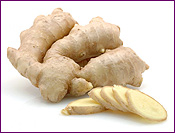Ginger Essential Oil
Zingiber officinale

Description
The aroma of Ginger Essential Oil can vary widely, depending on the distillation and quality of the root being distilled. The distillation of fresh ginger root can lead to an aromatically superior oil, one that I absolutely adore.

Topically, Ginger Essential Oil can be useful in blends and formulations intended to help improve circulation. It's a frequent addition to blends for massage, arthritis and muscle aches and pains.
When used topically at low dilutions or in a diffuser, Ginger Oil can help to ease nausea and motion sickness. Since Ginger Oil is so strong, I do not recommend that anyone without a formal education in herbalism or aromatherapy take it without being under the care of a qualified aromatherapy practitioner (instead, try Ginger Tea or Crystallized Ginger).

Aromatically, Ginger Essential Oil is spicy and warming. Though it is especially well suited for fall and winter months, I use it all year round. I love combining Ginger Oil in the diffuser with citrus oils and other spice oils.
Ginger Oil is one that is not a personal favorite to everyone, but is an oil that can significantly enhance a blend or synergy.
Emotionally, I find Ginger Essential Oil energizing and uplifting. It is considered an aphrodisiac. Its aroma is a wonderful addition to blends especially formulated for men (women love it too).
Spiritually, I personally find Ginger Essential Oil to be a welcome addition to my blends for expressing gratitude.
Ginger Essential Oil Benefits and Uses
- Aching Muscles
- Arthritis
- Nausea
- Indigestion
- Poor Circulation
- Nervous Exhaustion
Source: Julia Lawless, The Encyclopedia of Essential Oils (Updated Edition) (London: Harper Thorsons, 2014), 101-102.
Botanical Name
Plant Family
Common Method of Extraction
Steam Distilled
Plant Part Typically Used
Color
Light Yellow
Consistency
Thin
Perfumery Note
Middle/Base
Strength of Initial Aroma
Medium - Strong
Aromatic Description
Ginger Essential Oil smells warm, spicy, earthy and woody.
Major Constituents of Chinese Ginger Essential Oil
- Zingiberene
- ar-Curcumene
- B-Sesquiphellandrene
- B-Bisabolene
- Camphene
- B-Phellandrene
- Borneol
- 1,8-Cineole
- a-Pinene
- B-Elemene
Source: B.M. Lawrence, Progress in Essential Oils. (Perfumer & Flavorist 20 no. 2, 1995), 55. Source cited in Robert Tisserand and Rodney Young, Essential Oil Safety (Second Edition. United Kingdom: Churchill Livingstone Elsevier, 2014), 295.
Ginger Essential Oil Safety Information
Tisserand and Young do not indicate any known hazards for Ginger Essential Oil. Some sources do indicate that Ginger Oil is phototoxic. However, Tisserand and Young state that "Low-level phototoxic effects reported for ginger oil are not considered significant (Opdyke 1974 p. 910-902)." Reading Tisserand and Young's full profile is recommended. [Robert Tisserand and Rodney Young, Essential Oil Safety (Second Edition. United Kingdom: Churchill Livingstone Elsevier, 2014), 295.]
This profile pertains to the essential oil and not the CO2 extracts. Ginger CO2 Extracts contain constituents not present in the essential oil. Select and Total Ginger CO2 Extracts can be significantly stronger and more irritating and should be used with extreme care.
Ginger CO2 Supercritical Select and Total Extracts
In addition to being available as an essential oil, this botanical is available from a small number of reputable sources as a CO2 extract. CO2 extracts offer many advantages. However, they can have differing safety precautions than essential oils because the natural chemistry of CO2 extracts can differ from their essential oil counterparts. Not much safety information is documented from trusted sources for CO2 extracts. Use CO2 extracts with great care and do not assume that every CO2 extract has the same safety precautions as its essential oil counterpart.
General Safety Information
Do not take any oils internally and do not apply undiluted essential oils, absolutes, CO2s or other concentrated essences onto the skin without advanced essential oil knowledge or consultation from a qualified aromatherapy practitioner. For general dilution information, read AromaWeb's Guide to Diluting Essential Oils. If you are pregnant, epileptic, have liver damage, have cancer, or have any other medical problem, use oils only under the proper guidance of a qualified aromatherapy practitioner. Use extreme caution when using oils with children and be sure to first read the recommended dilution ratios for children. Consult a qualified aromatherapy practitioner before using oils with children, the elderly, if you have medical issues or are taking medications. Before using this or any essential oil, carefully read AromaWeb's Essential Oil Safety Information page. For in-depth information on oil safety issues, read Essential Oil Safety by Robert Tisserand and Rodney Young.
Shelf Life
Important Information About the Profiles
The essential oil information provided on AromaWeb is intended for basic educational purposes only. The references to safety information, test results, constituents and percentages is generalized information. Essential oils can vary greatly in composition. The data is not necessary complete and is not guaranteed to be accurate. The essential oil photos are intended to represent the typical and approximate color of each essential oil. However, essential oil composition and color can vary based on harvesting, distillation, age of the essential oil and other factors. Profiles for several CO2 Extracts and absolutes are included within the directory, and are denoted as such.
